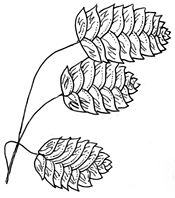
Description: Loosely tufted annuals or perennials.
Leaves with ligule obtuse, membranous; blade minutely scabrous on the margins.
Inflorescence a loose panicle with fine branches and nodding spikelets.
Spikelets solitary, pedicellate, the pedicels usually slender; florets 4–20, crowded and spreading horizontally, all bisexual but decreasing gradually in size towards the apex; rachilla disarticulating above the glumes and between the lemmas. Glumes subequal, persistent, concave, broad, 3–9-nerved, spreading horizontally. Lemmas closely overlapping, broad, with wide papery margins, deeply concave, 5–9-nerved, the nerves often obscure. Paleas to 60% the length of the lemmas, the 2 keels often winged and minutely hairy.
Distribution and occurrence: World: c. 20 species, temperate regions of Europe & South America. Australia: 3 species (naturalized), all States except N.T.
Species are widely naturalized in many countries and some are used for ornamental purposes. Key based on Wheeler et al. (1990).
Text by S. W. L. Jacobs & S. M. Hastings
Taxon concept:
| | Key to the species | |
| 1 | Spikelets 10–20 mm long | Briza maxima |
| Spikelets 4–5 mm long | 2 |
| 2 | Pedicels 10–15 mm long; panicle very open, symmetrical, composed of 10–20 spikelets; plants annual usually c. 20 cm high | Briza minor |
| Pedicels 2 mm long; panicle dense, 1-sided below, composed of numerous spikelets; plants perennial to 80 cm high
Back to 1 | Briza subaristata |
|


